Proper connection of the washing machine to the water supply and sewage system will allow washing for a long time without excesses. If you decide to do it yourself, then start by choosing a place.
Choosing a place to install a machine
Before the delivery of a large box from the store in which the washing machine is packed, you should choose the place where it will be installed. This is a stationary device, this distinguishes it from its previous developments, which could easily be moved around the apartment. Connecting the washing machine to the sewer and water supply is a prerequisite for normal operation, so it is advisable to decide on the place at the beginning:
- Many during the installation prefer the bathroom. This is not surprising, because the water supply is connected to the bath.
- Sometimes the size of the bathroom does not allow you to harmoniously integrate the washer, so you have to consider installing it in the kitchen.
- If you are the owner of a small apartment and there is no way to install the washing machine closer to the water pipes, it can be designed as part of the interior in the corridor. But to connect the machine to the water supply and sewerage, additional hoses will be needed.

Unpacking and installation
How to connect a washing machine? After delivery from the store, the purchase must be carefully unpacked. It is necessary to get rid of the fasteners that protected the unit during transportation and fixed all components from damage. Standard fasteners are made of bars, brackets, bolts.
The brackets are located under the rear cover of the machine and protect the cord and flexible hose from damage, as well as create additional rigidity when moving. The bars lie between the body and the tank and are easily removed by tilting it forward. Shipping bolts are located under the rear cover, they must be unscrewed.
If you forget to unscrew the transport bolts, the machine will vibrate terribly during the washing process, and when spinning and draining, it may slip out of place. After unscrewing the bolts for transportation, the machine drum should hang on the springs, this is necessary for further normal operation. The plastic plugs included in the kit should replace the unscrewed bolts. After removal, all parts of the fasteners must be folded and packaged, they will be needed in case of transportation to the service to eliminate the breakdown. What is the connection diagram of the washing machine?

Connecting the washing machine to the water supply can be performed in several versions, the main criteria for this are: the required pressure in the pipe and clean water. You can increase the water pressure by placing an additional pump in front of the washing machine, and it is cleaned with a filter grid. Under these conditions, you can connect water to the machine.
If the water supply is made of a metal pipe, you need to attach a flexible hose to one side of the washing machine, and screw on the valve on the other, which will be needed to insert into the pipe using a sleeve. Such a coupling consists of 2 halves, 1 of which has a threaded outlet for screwing in the valve. The coupling is put on the pipe and tightly fixed with bolts. For water to flow in, a hole must be illuminated through a threaded outlet, having previously shut off the water supply.
If plastic pipes are used for water supply, you can use it with a tee (fitting).

After choosing a place for tapping, a piece of pipe is cut out, and a fitting is inserted into the formed opening, on which a ball valve is fixed. The joints must be sealed with rubber cuffs.
Connection without water supply
And what about residents of the private sector, in whose homes there is no running water? Do not refuse to purchase an automatic washing machine. To connect the washing machine without running water, you need to install a water tank at a level above 1 m. Connect the machine and a water tank with a flexible hose. Thus, pressure will be created in the flexible hose, and the conditions necessary for the operation of the machine will be met. The drain for the washing machine is connected to the drainage system.
Connection to the sewerage
How to connect a drain? The supplied clean water is half the task, then - connecting the washing machine to the sewer. In this case, using several simple methods, you can quickly and easily make a reliable drain for the washing machine into the sewer.

The easiest way to drain the water is with a plastic hook-shaped fixture. Put it on the corrugated hose and hook it over the edge of the tub or sink.
What height should the washing machine drain hose be at? The main condition is that the upper part of the hose should be no higher than 60 cm from the drain of the washing machine to the sewer. If desired, you can connect the machine to a special siphon with a tap for water, you can buy it at a plumbing store.
You can connect the washing machine to the sewer without a siphon. In this case, make sure that the hose does not touch the wastewater. You may need to purchase an adapter with a check valve so that the washing machine does not drain into the sewer in the opposite direction. If you do all the manipulations correctly, then connecting the drain of the washing machine will not be a problem.
Before connecting the machine to electricity, you must first prepare the grounding. The socket should be used 3-wire, since contact of water with electricity can cause a lot of trouble.
Many women consider the best achievement of high technology. They make life much more comfortable and save a lot of time. Having such an aggregate is not necessary to collect dirty things for a long time. Laundry can be started at least every day. If you do not know how to connect the washing machine to the water supply and sewerage, then our article is for you. Using our recommendations, you can install such an aggregate with minimal financial costs and on your own.
For high-quality operation of a useful unit, you need to responsibly approach its connection
Connecting the washing machine to the water supply and sewerage: where to put the unit
To bring the washing machine home and install it properly, you need to choose the best place for it. This is stationary equipment, to which certain communications are supplied and cannot be moved.
Most often, the connection to the water supply and sewage system is made in the bathroom. This is convenient, as pipelines are run in this room. It’s also easy to arrange a drain. But if the area in the bathroom is not enough, then the machine can be placed in the kitchen.
Non-standard installation options include equipment location c. You can use the integrated solutions.
How to independently connect a washing machine: preparing for installation
If you decide to connect the washing machine with your own hands, then you should prepare for this. First of all, the equipment must be unpacked and freed from fasteners. Rear brackets are placed that are required to secure the hose and power cable. These elements give rigidity to the entire structure.
The bolts that hold the drum are installed on the front wall. All items should be removed and put away for storage. They may be needed when visiting the service.

Helpful information! To remove all shipping fasteners, do not start the equipment. This will harm the drum.
Water inlet
There are several ways to organize the connection of the washing machine to the water supply and sewerage. Remember that for any of the methods the pressure in the lines must have an optimal pressure, and the water must be purified. To increase the pressure, a special pump should be installed in front of the equipment. For cleaning, a filter mesh is useful.

Let's analyze the following options for connecting equipment:
- the use of crimp couplings. Connect the special hose to the equipment and to the valve that cuts into the structure. This part contains two halves that are put on the pipe and tightened with bolts. A hole is drilled to pass water;

- for metal pipes, a specialized tee or fitting is used. At the selected site, an element is cut out and a fitting is connected, to which, in turn, a ball valve is mounted to connect the washing machine to the water main;

- the easiest method is to connect the unit using a hose to the mixing unit or bring it to the toilet flush tank. It is better to choose the length of the used hose with a margin, and a special tee is selected for it. Before washing, the mixing hose will need to be unscrewed each time. This is a good way to connect if the equipment and the toilet are located in the same room;
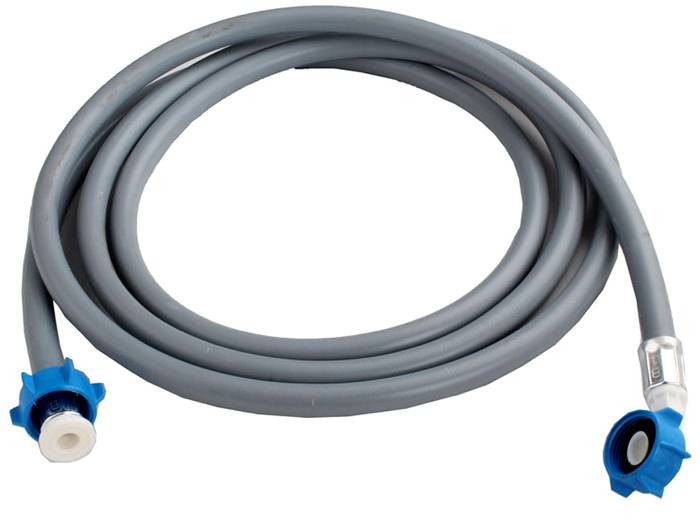
Flexible eyeliner complete with technology
- if there is no running water in the dwelling, then the equipment can also be connected. To do this, a tank of water rises to a small height, and from its bottom a hose is brought to the input to the machine. This will create the necessary pressure in the system.
Related article:
Getting to the choice, you need to decide which model of technology is better and better. This is the question we will try to understand in detail in this review.
How to connect a washing machine to the sewer
Watch the video installation of the washing machine with your own hands. It is not enough to bring water, it is worth considering the removal of contaminated water, which remains after washing.
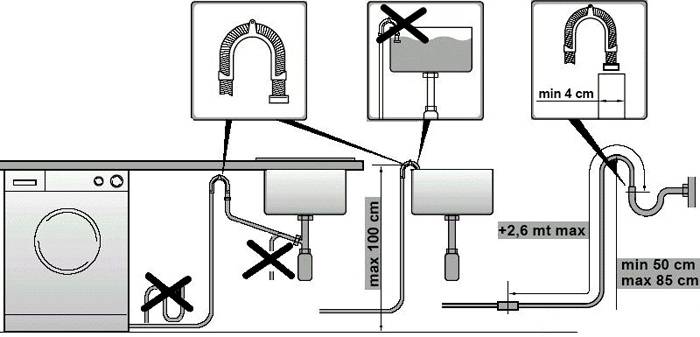
Connection is also done in various ways:
- flush to the toilet or to the bathroom. In this case, the upper part of the hose should be mounted 60 cm higher than the washing machine. Special fasteners will be required;
- to discharge dirty drains, a siphon is used, in which a branch is located. It should be placed under the knee of the siphon;
- water is discharged through the highway, the thickness of which is 4-5 cm. The output is installed directly on it. A sealant is also used, and the hose is wound behind the pipe so as not to affect sewage fluids. The top edge should be no lower than one and a half meters from the floor.
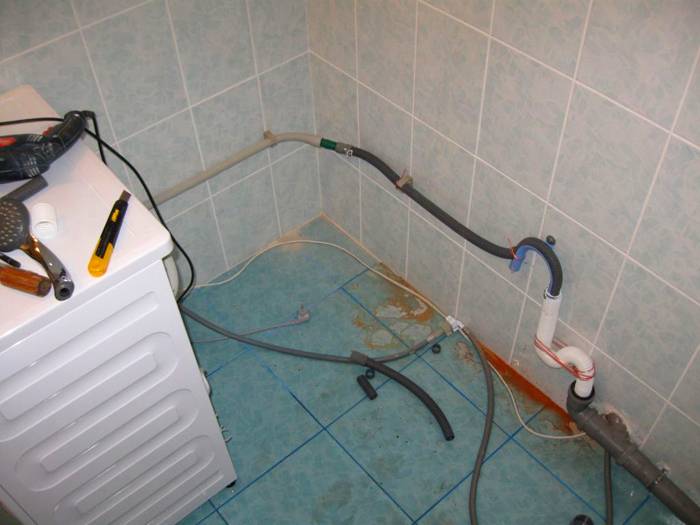
Helpful information! If your equipment does not have a check valve, then it must be mounted taking into account the special water restriction.
Work with electrical wiring
After organizing the drain, it is necessary to connect the washing machine to the mains. It is important to pay more attention to this issue. After all, the combination of water with electricity can end in tragedy.

The diagram shows an example of a competent connection
First ground the switchboard. At the same time, the thickness of the tire intended for this should not be less than 3 mm. The socket must also have a ground terminal. If the equipment is mounted in the kitchen, then it can be connected to an electrical outlet.
The best option for connecting the washing machine is to use a separate wire that comes from the counter. In this case, the machine is installed without fail. If there is no separate wiring, then you can use a special RCD.
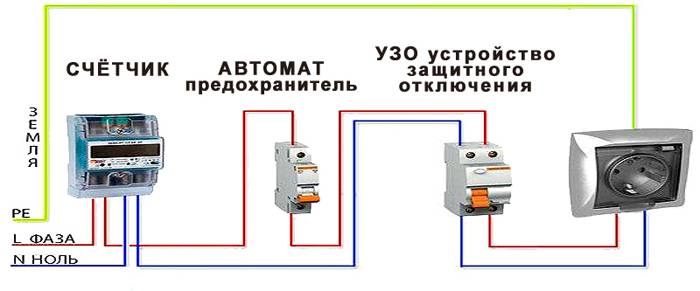
Helpful information! It is forbidden to connect grounding to heating batteries and to different pipes.
How to put legs
The washing machine is installed in a strictly horizontal position. In this case, the drum is located without distortions. Possible deviation - only 2° . To achieve an even location, the legs are adjusted. The plane is checked using a level. Do not use blocks, rugs or pieces of linoleum to level the machine.

Related article:
We will figure out how to clean the washing machine with citric acid and other improvised means to increase the life span of the appliance.
Verify proper operation
After assembly, it is important to check all connections and connection points. Then check the circuit again and conduct a test run. It is important to complete all operations in order.
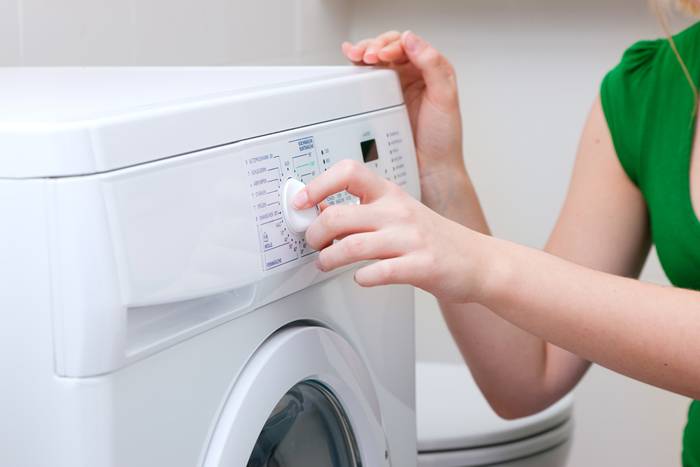
Fill the tank with water. Note the time of his typing. It must match what is indicated in the passport. In doing so, check for leaks in the connections. If this is present, then the water needs to be drained and everything fixed. Then the machine turns on. After 5-7 minutes, the water is heated to a suitable temperature. When starting up the equipment, the appearance of extraneous noise is not permissible. All modern units should work silently. If you hear a rattle and rattle, then this indicates a possible equipment malfunction. It is necessary to determine the causes of noise. Then you should check how the squeezing device functions and the operation of the drain structure. If everything works as described in the instructions, then you can use the technique.

Video: installation and connection of the washing machine
Automatic washing machines quickly became recognized by housewives, almost immediately replacing old models, which today are already considered an anachronism. Now the housewives are not even afraid of the need for a “big wash,” since the machine does almost all the physical work for them.
It can be difficult to choose a washing machine these days: they are presented on the market in a very wide assortment and vary by manufacturer, by functional features and by price level. At the same time, not everyone knows how to properly connect the machine to the water supply and sewage systems, therefore, in serious salons of household appliances, this service is often offered to customers as an extra.
If such a service is not provided in the salon, you can use the services of private masters, but they take a lot of money for their work. But even a not-so-skilled owner can easily do the machine’s connection to the sewer and do-it-yourself water supply.
How to connect a washing machine with your own hands
The process of installing the machine and connecting it to communications can begin immediately after it is delivered to the right place. The main steps in this process are as follows:

It is very important that each stage is carried out when the owner has enough free time: most of the mistakes that are made when connecting the washing machines with their own hands happen in a hurry. In addition, moving on to each next step, you need to clearly understand what exactly and what you need to do.
Choosing the right place to install the washing machine
The most important condition for installing an automatic machine is the ability to supply water to itorganizing a drain into the sewer and connecting the machine to the electrical network. Most often, cars are installed in bathrooms, combined bathrooms or in kitchens.
Sometimes you can see a car installed in the corridor, but such options are almost always accompanied by the presence of long hoses for water and its discharge, and this is extremely undesirable, since they not only interfere, but increase the likelihood of emergency situations.
In the kitchen, free-standing washing machines are installed or built into kitchen sets. The second option is becoming more common every day, since typical kitchen apartments usually have miniature sizes and often other installation options for washing machines in these rooms are unacceptable.
Many people think that dirty linen should not be in those rooms where food is prepared, and not everyone can use enough neat laundry detergent where food products are lying openly. However, the bathroom has an even more significant drawback, namely, high humidity. Here it is necessary to arrange a good exhaust hood or organize forced ventilation, otherwise water vapor will cause problems with the electronics, and the metal parts of the machine will corrode more quickly.
You should also check for reliable grounding of the electrical lines. It is important to know that you can only connect the washing machine to an outlet with three contacts, and grounding should not be removed from heating pipes or water pipes.
On the video on the Internet you can see that the washing machine can also be installed in the toilet, if you observe sufficient safety precautions.
Moreover, you should also consider such points:

If the machine is installed correctly, it should stand stably on the floor, and if it is too slippery, you can lay a rubber mat under the machine.
Getting the machine out of transport parts
To start installing the machine, you should rid her of cardboard packaging: that is, remove the box from the machine and remove the foam inserts.
The packaging design is often reinforced with wooden bars that are mounted on screw legs. They must be removed, then open the main hatch of the machine and check if there were any stop elements installed, as is customary with some manufacturers.
The locking screws that hold the drum in the optimum transport position must be unscrewed. Usually 4 or 5 of these screws are located on the back of the machine. They are removed, and plugs are inserted into the holes remaining from them. It is recommended that the screws be retained together with the bushings: they are still useful if you need to transport the machine to another location.
There can be many options for connecting the machine to the water supply: the choice depends on the specific conditions and on the plumbing skills of the home foreman. A hose is included with the machine, one end of which l-shaped and hands with a certain effort is screwed onto the nozzle of the device. The second end is connected in an affordable way to the water supply.
The ways to connect the machine to the water supply can be as follows:

In polypropylene pipes weld a special element for washing machines is very simple. And the laziest ones can connect the hose of the washing machine directly to the mixer in the bathroom. Many believe that using such a connection is also quite convenient.
Connecting the machine to the sewer
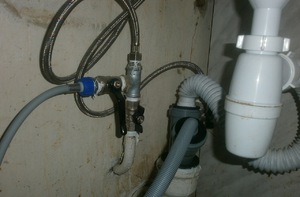 In order to connect the machine to the sewer, you need to know several nuances and features of this process. The easiest way to use a special nozzle, which is put on the drain pipe and pumps water directly into the bath or sink.
In order to connect the machine to the sewer, you need to know several nuances and features of this process. The easiest way to use a special nozzle, which is put on the drain pipe and pumps water directly into the bath or sink.
However, this method is suitable only for those who wash only occasionally, since not everyone is calm about the fact that soapy dirty water flows to the same place where people wash dishes or people have to bathe. In addition, with such a connection, the washing process has to be carefully monitored: the pressure in the machine hose is uneven, as a result of which the hose can fall and cause a lot of trouble. To prevent this from happening, it’s best fasten it with a chain or cord.
It is most convenient to permanently connect the machine to a sewer pipe, "while it is imperative to provide for an air gap in the drain hose, the height of which cannot be less than the maximum level of water drawn into the bathroom. If this is not done, a" siphon "effect may occur, as a result of which It will start to suck out water from the machine on its own. Such a situation causes automatic programs to malfunction and can even lead to the return of water from the sewage system to the machine. It is best to use A special siphon with a nozzle for drainage hoses To prevent water from escaping from the machine, the hose should be fixed at the top of the rear panel.
If not enough hose length, it can be increased, but it should be noted that for too long a hose the pump power may not be enough. The length of the hose should not exceed 3-5 m3.
Putting the machine in place and trial run
The main point in the installation of the machine is its perfect alignment in horizontal and vertical planes. To do this, the machines are equipped with adjustable legs, which can be rotated with the key supplied with the device. To verify the correct installation, a water construction level is used.
Each support should be pressed firmly to the floor, leaving not the slightest gap. When the machine is installed, it should fasten the screws with locknuts and check stability again. If even the smallest backlash is detected, alignment is required once again so that the machine does not begin to “walk” during the spin cycle and does not make too loud sounds.
When the installation process is completed, you need to connect the machine to the mains and start in test mode (for example, in the washing mode with a little heating), not forgetting to open the water supply tap first. The connection can be considered completed if the machine did not rattle during the test wash, did not move, and successfully completed the task assigned to it.
- Choosing a place and preparing to install a washing machine
- Bringing water to the machine
- Connecting the device to the sewer and the mains
- Connecting the machine to the mains
- Washing machine installation
Buying a washing machine can solve several important problems at once. If you cope with connecting the washing machine to the water supply and sewage system, life will become much easier. You don’t have to spend a day on global washing, but you can wash it as needed. The only question: how to properly connect the washing machine.
Choosing a place and preparing to install a washing machine
Even before installing the machine, it is important to determine the location for it. “Avtomat” is connected to the power grid, water supply and sewage system; if necessary, it cannot be moved to a more convenient place.
Traditionally, a washing machine is installed in the bathroom. There, it doesn’t catch the eye of guests, the sound from work does not interfere, and besides, water and sewer pipes are located nearby. But the problem is that the bathrooms in typical houses are very small and there may not be room for cars. In this case, you can transfer it to the kitchen and already look for a corner there.
If there was no place in the kitchen, you will have to improvise. For example, you can try installing a washing machine in the hallway, and then equipping the doors to close it.

The washing machine was bought and delivered to the apartment. Now you need to unpack it and prepare for installation. First of all, the box is removed. Then the elements that fix the machine are removed. They are bars and staples designed to protect rotating parts.
Please note that all locking parts must be removed before first use, otherwise the drum may be damaged.
The brackets on the back of the washing machine fix the hose and cord, and also increase the stiffness necessary for transportation. Bars are placed between the tank and the machine body itself. In order to remove them, you need to slightly tilt the machine.
Bolts hold the drum; they are on the front of the device. After removing them, the drum freezes on springs. To return it to the correct position, you need to put plastic plugs in the freed holes from the bolts, they are included in the kit for the machine.
After removal, the bolts, staples and bars must be folded into a box and stored until the machine serves: they may be needed if you have to contact the service.
Back to the table of contents
Bringing water to the machine
When connecting the washing machine to the water pipes, it is important to consider two main parameters:

- degree of water pollution;
- water pressure.
The water for the washing machine must be clean. If necessary, a filter screen can be installed on the pipes for cleaning. The normal pressure is at least 1 bar. If the water pressure is too low, it can be increased by installing a booster pump in front of the device.
These two requirements apply to all machines, regardless of the type and method of connection.
The following methods are used to install the “washer”:
- using a coupling;
- using fitting;
- using a tee;
- without running water.
In the first case, you need to take a hose, the diameter of which should be 3/4 inch. One end is connected to the machine, and the other to the pipe using a crimp sleeve.
The crimp coupling consists of two parts that are put on the pipe, and then bolted, and also from the branch, a ball valve is screwed on it. Then, a hole for a water wire is drilled in the coupling. This method of water supply is suitable if the water pipes are metal.
To bring to metal-plastic pipes, a fitting is used, that is, a special tee. To install the device in the pipe, a hole is cut into which the fitting is inserted. A crane is attached to it, preferably a ball valve, and the bonding points are sealed with rubber cuffs.

Connecting a washing machine with your own hands using a tee is a simple and quick option, which is most often only a temporary measure. Using a long hose, the washing machine is connected to the toilet water supply or to the mixer. A tee is usually used for connection.
The disadvantage of using this method is that each time before washing, you will have to unscrew this faucet. Moreover, such a connection does not look very aesthetically pleasing. You can resort to this method only if the toilet and the washing machine are located close to each other.
Water supply is not available in all houses, but this does not mean that you will have to abandon such a convenient device as an automatic machine. It is enough to install it correctly.
To do this, take a water tank with a volume of at least 40 liters. The installation height of such a tank should be at least one meter from the floor surface, but it is better if the height of the tank is greater. In the tank you need to lower the small pump and bring the hose to the inlet of the machine. Thus, optimal pressure will be created and the device will work perfectly.
Back to the table of contents
Connecting the device to the sewer and the mains
After the water is brought to the machine, you need to decide how to drain the washing machine into the sewer. There are also several options for this. You can drain:
- in the toilet;
- through a siphon;
- through sewer pipes;
The easiest way to connect the drain of the washing machine is to lower the hose into the bathroom, sink or toilet.

When using a sink to drain, a hose mount should be provided. At the same time, one requirement must be observed: the upper part of the hose should be at least 60 cm higher than the washing machine. For this, fastenings are provided.
A more convenient option is to mount a stationary water drain. First you need to buy a siphon with a tap to connect the washing machine (it is very easy to find such a model in the store). The main thing in this case: make sure that the bend is installed above the siphon elbow. If you do not follow this rule or connect the machine to the sewer itself, the waste water will be sucked in, resulting in an unpleasant odor.
Connecting the washing machine to the sewage system without using a siphon is possible only if the sewer pipe has a rather large thickness - 4-5 cm. You can install a tap on it, to which you need to attach the hose from the washing machine so that it does not fall to the level of wastewater and was at least 0.5 cm from the floor.
